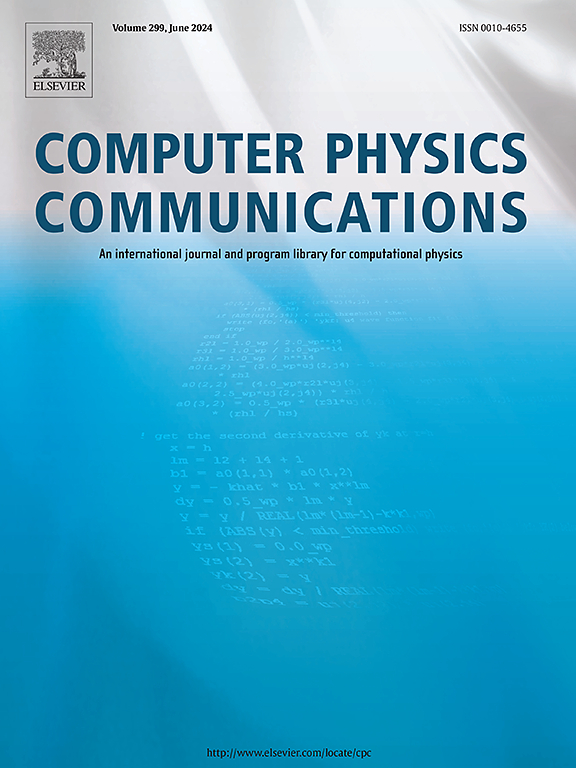一个新的CUDA改进和优化版本的量子耗散动力学包的公告
IF 3.4
2区 物理与天体物理
Q1 COMPUTER SCIENCE, INTERDISCIPLINARY APPLICATIONS
引用次数: 0
摘要
量子耗散动力学(QDD)包的第三个版本是继第二个版本之后发布的。M. Dinh等人,《比较物理学》。Comm. 295(2024) 108947],其中重点主要放在电子动力学的优化上,特别是使用CUDA fortran编码以允许使用GPU。在这个新版本中,我们在CUDA-capable gpu上追求QDD的其他部分的输出,作为离子运动,电子与激光场和/或与离子的耦合(通过伪势),以及所有电子观测,包括所涉及的光电子能谱,能量和/或角度分辨。几个特定的CUDA优化也已经实现,以提高性能和内存使用,同时保持结果的准确性。新版本程序摘要程序标题:QDDCPC库链接到程序文件:https://doi.org/10.17632/2fg47zm4mz.1Licensing条款:gplv3编程语言:Fortran 90, CudaFortranJournal参考前版本:p.m.d inh, et al., Comp. Phys。Comm. 295(2024) 108947新版本是否取代旧版本?新版本的原因:在第二个版本中,QDD包没有完全移植到支持cuda的GPU上。修订总结:QDD的变化是双重的。一个是在图形处理器上导出离子运动的计算和对所有可观测值(电子和离子)的计算,以及赝势计算方面的一些变化。因此,一个主要的数字改进已经实现了85%的加速。第二个变化包括一些纯粹的CUDA优化,加速更适度:大约%,具体取决于GPU的类型。详见补充资料。问题性质:可能的数值优化将被测试,在离子运动方面,量子电子与外部场(离子,激光)的耦合,以及在纯GPU使用的水平上。解决方法:这个新版本通过CUDA编码完成了离子运动,量子电子与外部场(离子,激光场)和所有电子观测的耦合的导出到GPU。其他评论包括限制和不寻常的功能:整体加速可能强烈依赖于可用的GPU类型(来自HPC中心或工作站)。本文章由计算机程序翻译,如有差异,请以英文原文为准。
A new CUDA improved and optimised version announcement of the quantum dissipative dynamics package
The third release of the Quantum Dissipative Dynamics (QDD) package follows the second release [P. M. Dinh, et al., Comp. Phys. Comm. 295 (2024) 108947] in which the focus was mainly made on the optimization of the electronic dynamics, in particular with a CUDA fortran coding to allow the use of a GPU. In this new release, we pursued the exportation of other parts of QDD on CUDA-capable GPUs, as the ionic motion, the coupling of the electrons with a laser field and/or with the ions (via pseudopotentials), and all electronic observables, including the involved photo-electron spectra, energy- and/or angle-resolved. Several specific CUDA optimisations have also been implemented, to improve the performance and the memory usage while keeping the accuracy of the results.
NEW VERSION PROGRAM SUMMARY
Program Title: QDD
CPC Library link to program files: https://doi.org/10.17632/2fg47zm4mz.1
Licensing provisions: GPLv3
Programming language: Fortran 90, CudaFortran
Journal reference of previous version: P. M. Dinh, et al., Comp. Phys. Comm. 295 (2024) 108947
Does the new version supersede the previous version?: No
Reasons for the new version: The QDD package was not fully ported on a CUDA-capable GPU in the second release.
Summary of revisions: The changes in QDD are twofold. One concerns the exportation on the GPU of the computation of the ionic motion and of the computation to all observables (electronic and ionic), and some changes at the side of the calculation of the pseudopotentials. A major numerical improvement has been therefore achieved 85% of speedup. The second change consists in some pure CUDA optimization with a more modest speedup: some %, depending on the type of GPU. See Supplementary Material for more details.
Nature of problem: Possible numerical optimizations were to be tested, at the side of the ionic motion, the coupling of the quantal electrons with external field (ions, laser), but also at the level of pure GPU usage.
Solution method: This new version completes the exportation to a GPU by a CUDA coding of the ionic motion, the coupling of the quantal electrons with external fields (ions, laser field) and all electronic observables.
Additional comments including restrictions and unusual features: The overall speedup can strongly depend on the type of GPU available (from an HPC centre or a workstation).
求助全文
通过发布文献求助,成功后即可免费获取论文全文。
去求助
来源期刊

Computer Physics Communications
物理-计算机:跨学科应用
CiteScore
12.10
自引率
3.20%
发文量
287
审稿时长
5.3 months
期刊介绍:
The focus of CPC is on contemporary computational methods and techniques and their implementation, the effectiveness of which will normally be evidenced by the author(s) within the context of a substantive problem in physics. Within this setting CPC publishes two types of paper.
Computer Programs in Physics (CPiP)
These papers describe significant computer programs to be archived in the CPC Program Library which is held in the Mendeley Data repository. The submitted software must be covered by an approved open source licence. Papers and associated computer programs that address a problem of contemporary interest in physics that cannot be solved by current software are particularly encouraged.
Computational Physics Papers (CP)
These are research papers in, but are not limited to, the following themes across computational physics and related disciplines.
mathematical and numerical methods and algorithms;
computational models including those associated with the design, control and analysis of experiments; and
algebraic computation.
Each will normally include software implementation and performance details. The software implementation should, ideally, be available via GitHub, Zenodo or an institutional repository.In addition, research papers on the impact of advanced computer architecture and special purpose computers on computing in the physical sciences and software topics related to, and of importance in, the physical sciences may be considered.
 求助内容:
求助内容: 应助结果提醒方式:
应助结果提醒方式:


